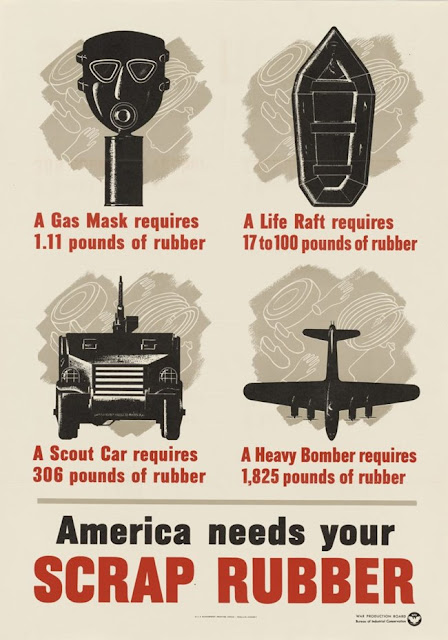It was 1942 before the United States really and suddenly felt the need to salvage waste materials for recycling into war materials. Drives were held to collect rubber, paper, waste fats from the kitchen, shellac, aluminum, steel and iron, among other things. Americans were told it took 15 tons of scrap metal to create a medium sized table and 3 tons to make a small anti-aircraft gun. Tons of scrap metal was needed, so in addition to collecting it, refrigerators, cars and cutlery were not available during the rest of the war years. Housewives donated old pots and pans, metal toys, broken tools and equipment.
Some towns sent in their historic cannons or the metal in monuments, as well as old car parts, wrought iron fences and whatever else could be used. School children had their own drives and competitions.
Citizens were asked to donate rubber boots, old tires, life rafts, hot water bottles, garden hoses, and anything else appropriate.
This recycled rubber was mostly used to retread tires, and the better quality was used for military needs. If a family had more than five tires at their residence, they were required to sell back the extras. Speed limits were lowered to reduce stress on the retreads. By 1944, Firestone, B.F. Goodrich and a few others could produce enough synthetic rubber, so that rubber was no longer collected.
A shortage of fabric was also known, beginning in 1942, as more uniforms were required, as well as bedding and anything else using fabric. To help in saving, the government banned the making of suit vests and 2 piece bathing suits, for example.
Women of the day often had a tin ready under the sink to pour in extra fats, or they had a place in the basement to keep it cool. These would then be turned into the local butcher for a few pennies. It was used for soap production and for explosives.
The business of the military used a great deal of paper, so paper recycling was already a thing during the war. Not only was it used for writing, but for packaging ammunition and for insulation. Paper recycling was a popular school project.
The business of the military used a great deal of paper, so paper recycling was already a thing during the war. Not only was it used for writing, but for packaging ammunition and for insulation. Paper recycling was a popular school project.
The people of the United States were eager to help win the war, and they did their part to skimp for themselves and donate what was needed.






No comments:
Post a Comment